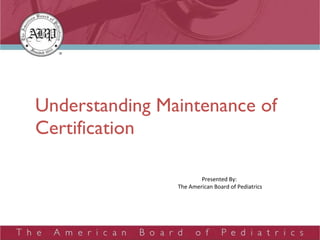
Pediatric Maintenance of Certification
- 1. Understanding Maintenance of Certification Presented By: The American Board of Pediatrics
- 3. The Evolution of Board Certification Permanent Certification Until 1988, certification was done by successfully passing a test of knowledge only once in a career, typically at the end of training. Time-Limited Certification Beginning in 1989, a diplomate was required to successfully pass a similar test of knowledge every 7 years. Maintenance of Certification (MOC) Beginning in 2010, diplomates will maintain certification by continual evaluation of the competencies verified during residency. A secure test of knowledge is one part of this four-part program.
- 4. The ABP certifies physicians who demonstrate a commitment to lifelong learning and providing the highest quality care. Certification is a self-regulated, professional responsibility.
- 7. Measuring the 6 Core Competencies Part 1 – Professional Standing Patient care, Interpersonal & communication skills, Professionalism Part 2 – Knowledge Assessment Patient care, Medical knowledge, Practice-based learning & improvement, Systems-based practice Part 3 – Cognitive Expertise Medical knowledge Part 4 – Performance In Practice Patient care, Practice-based learning & improvement, Interpersonal & communication skills, Professionalism, Systems-based practice
- 11. Because examinations are only required every 10 years, it’s important to note that the exam does not necessarily coincide with the beginning or end of your 5-year MOC cycle. NOTE!
- 13. Part 4 MOC – Menu of Options 2 options for completion Web Based Modules MOC Points EQIPP Modules from AAP* (asthma, ADHD, nutrition, immun, development) 15 Performance Improvement Modules (PIMs) from ABP 5-10 ABMS Patient Safety Module 15 Other ABMS board modules 5-10 ABP Approved QI Projects** Vermont Oxford Network (2 projects) 20 California Perinatal Quality Care Collaborative 20 NACHRI Blood Stream Infection Project 20 Iowa BCBS Asthma and Immunization 20 UPIQ (state wide obesity project in Utah) 20 Cystic Fibrosis Foundation 20 CHCA (2 projects on hospital codes and throughput) 20
- 14. Part 4 MOC – Performance In Practice AAP Web-based Modules Patient Safety Improvement Program Examples of Option 1 (Web-based QI Project)
- 15. Part 4 MOC – Performance In Practice 29 children’s hospital PICUs are collaborating to reduce catheter-related bloodstream infections. This project has been approved by the ABP for Part 4 credit and points. Example of Option 2 (Collaborative QI Project)
- 16. Part 4 MOC – Performance In Practice Another Example of Option 2 (Collaborative QI Project) 160 practicing pediatricians decided to work together to improve care for their children with asthma. They set an ambitious goal – that all 44 participating practices would achieve “perfect care.” Together, the physicians created the infrastructure necessary to measure improvement, created data collection and patient tracking procedures and trained coaches to help. Within 2 years, the network moved from a 4 percent compliance rate in applying “perfect care” to an 88 percent rate. Perfect Care for Asthma (Cumulative %) Long Term Goal = 95% Results: 44% hospital admissions 22% urgent care/ED visits 30% missed school days
- 17. Parts 2 and 4 – How It All Adds Up! A total of 100 points is required per 5-year MOC cycle. 40 points – Part 2 activities + 40 points – Part 4 activities + 20 points – Your choice (Part 2 or 4 activities) 100 required points per 5-year MOC cycle